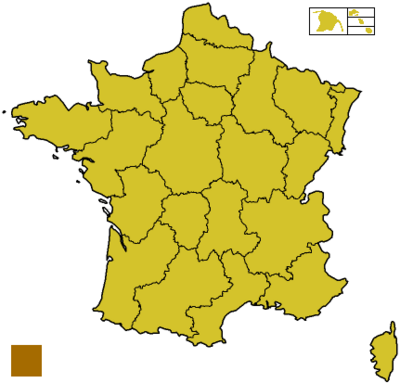Regions of France
 |
|
This article is part of the series on
Administrative divisions of France |
|
Regions
(incl. overseas regions) |
|
(incl. overseas departments) |
|
Urban communities |
|
Associated communes |
|
Others in Overseas France
Overseas collectivities |
France is divided into 26 regions or régions (in French), of which 21 are in continental metropolitan France, one is the island of Corsica, and four lie overseas. Regions in mainland France and Corsica are further subdivided into between 2 and 8 departments or départements.

de Calais
Normandie
Ardenne
Normandie
Charentes
Roussillon
Côte d'Azur
Biscay
Contents |
General characteristics
In metropolitan France (excluding Corsica), the median land area of a region is 25,809 km² (9,965 sq mi), which is about one-fifth of the median land area of a U.S. state, and only 4% as large as the median land area of a Canadian province, but 15% larger than the median land area of a German state, and 67% larger than the area of a region of England.
In 2004, the median population of a region in continental France was 2,329,000 inhabitants, which is a little less than one-half of the median population of a region of England, a little more than one-half of the median population of a U.S. state, and three-quarters of the median population of a German state, but more than twice the median population of a Canadian province.
Role
Regions do not have legislative autonomy, nor can they issue regulations. They levy their own distinct taxes (and receive a decreasing part of their budget from the national government which gives them a portion of the taxes it levies) and have considerable budgets, managed by a regional council (conseil régional) with elected representatives from the regional elections.
Their main legal attribution is to build and pay equipment costs for lycées; in March 2004, the French national government announced a controversial plan to transfer to the regions some categories of non-teaching school personnel. Critics of this plan contend that it is doubtful that sufficient fiscal resources for these additional charges will be transferred, and that such measures will increase inequalities between regions.
Apart from these legal attributions, regions have considerable discretionary spending for infrastructure (education, public transportation systems, aid to universities and research, support for entrepreneurs). Because of this, being president of a wealthy region such as Île-de-France or Rhône-Alpes may be quite a high profile position.
There are, from time to time, discussions about giving limited legislative autonomy to the regions, but such proposals are controversial. There are also proposals to suppress the local government of the departments and transfer them into their respective regions, leaving the departments with very limited authority.
History
See also
- Regional councils of France
- Administrative divisions of France
- Ranked list of French regions
- French regional elections, 2004
- Flags of French regions
External links
- (English) Regions of France at the Open Directory Project
- Local websites by region
- Maps of France
|
|||||
|
||||||||